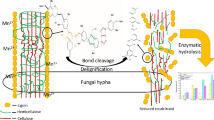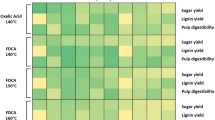Abstract.
.Ligno-cellulosic substrates (LCSs) isolated from wheat straw and bran exhibit high complexing capacities and may have important applications for metal removal from industrial effluents. These two LCSs were examined in the present work by spectroscopic and pyrolytic methods (solid state cross polarization magic angle spinning (CP/MAS) 13C NMR, XPS, conventional Curie pyrolysis (Cupy)/GC/MS, and TMAH thermochemolysis/GC/MS). This combined study highlighted the limitation of some of the above methods when applied to ligno-cellulosic materials and the resulting biases and the usefulness of TMAH thermochemolysis. A large difference in composition was observed between bran- and straw-LCS due to a much higher contribution of alkyl moieties in the former. These moieties correspond to fatty acids esterified to the ligno-cellulosic macromolecular structure and such carboxylic functions should play an important role for metal complexation.
Similar content being viewed by others
Author information
Authors and Affiliations
Additional information
Electronic Publication
Rights and permissions
About this article
Cite this article
Gauthier, A., Derenne, S., Dupont, L. et al. Characterization and comparison of two ligno-cellulosic substrates by 13C CP/MAS NMR, XPS, conventional pyrolysis and thermochemolysis. Anal Bioanal Chem 373, 830–838 (2002). https://doi.org/10.1007/s00216-002-1371-2
Received:
Revised:
Accepted:
Published:
Issue Date:
DOI: https://doi.org/10.1007/s00216-002-1371-2




